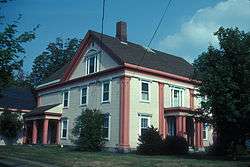Connor-Bovie House
The Connor-Bovie House is a historic house at 22 Summit Street in Fairfield, Maine. Built 1856–58, this house is a locally distinctive example of Greek Revival and Italianate styling. It is also significant as the home of William Connor, a prominent regional lumber baron, and as the home of his son Seldon, a general in the American Civil War and three-term Governor of Maine. The house was listed on the National Register of Historic Places in 1974.[1]
Connor-Bovie House | |
 | |
  | |
| Location | 22 Summit Street, Fairfield, Maine |
|---|---|
| Coordinates | 44°35′14″N 69°36′3″W |
| Area | 1 acre (0.40 ha) |
| Built | 1856 |
| Architectural style | Greek Revival |
| NRHP reference No. | 74000321[1] |
| Added to NRHP | January 18, 1974 |
Description and history
The Connor-Bovie House is a 2-1/2 story wood frame structure, three bays wide, with a side gable roof, clapboard siding, and granite foundation. An ell extends to the rear, joined to a structure that probably served once as a carriage house. The bays of the south-facing main facade are delineated by paneled Doric pilasters, and the windows are framed by Italianate molding. The main entrance is sheltered by a portico, supported by paneled Doric columns, with a porch above. Both the main entrance and the doorway to the porch have flanking sidelight windows.[2]
The house was built 1856-68 by William Connor, one of the proprietors of the main lumber mill in Fairfield, and a major area landowner. Connor's son Seldon (1839-1917), served as a brigadier general in the Union Army during the American Civil War, and was Governor of Maine 1876-78. The house was sold out of the family in 1939, to William T. Bovie, a surgeon who is credited with invention of the cauterizing "Bovie knife".[2]
References
- "National Register Information System". National Register of Historic Places. National Park Service. July 9, 2010.
- "NRHP nomination for Connor-Bovie House". National Park Service. Retrieved 2015-01-24.